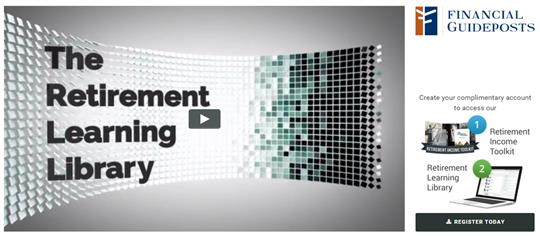|
Email not displaying correctly? View it in your browser.
| |
FINANCIAL FOCUS
February 2016 Newsletter
|
| |
We Have Launched Our
Retirement Learning Library!

Our goal in creating this educational site, is to provide you with insightful
information about the financial retirement issues we help people with on a
day-to-day basis. Watch Videos and create your own account!

Please take a moment to visit our site www.fguniversity.com
and let us know what you think!
|
| |
Give Your Retirement Plan an Annual Checkup

We recommend that you review your retirement savings plan annually and when major life changes occur. If you haven’t already revisited > Read more...
|
|
Organizing Important Records and Documents

A record keeping system is a systematic approach to retaining and filing documents in a way that makes them easy to find when needed, even if it's several > Read more...
|
| |
Hidden Costs of
Social Security

Due to recent budget legislation that removed two advanced filing strategies used by retirees, Social Security has, once again, been in the headlines. > Read more...
|
|
Did You
Know?

From its origins to its sweet, chocolaty modern traditions, how much do you really know about Valentine's Day? Some of these facts may surprise you! > Read more...
|
| |
At Financial Guideposts, we recommend that you review your retirement savings plan annually and when major life changes occur. If you haven’t already revisited your plan, the beginning of a new year may be the ideal time to do so.
|
| |
|
|
|
Re-examine your risk tolerance
This past year saw moments that would try even the most resilient investor's resolve. When you hear media reports about stock market volatility, is your immediate reaction to consider selling some of the stock investments in your plan? If that's the case, you might begin your annual review by re-examining your risk tolerance.
|
| |
Risk tolerance refers to how well you can ride out fluctuations in the value of your investments while pursuing your long-term goals. An assessment of your risk tolerance considers, among other factors, your investment time horizon, your accumulation goal, and assets you may have outside of your plan account. Your retirement plan's educational materials likely include tools to help you evaluate your risk tolerance, typically worksheets that ask a series of questions. After answering the questions, you will likely be assigned a risk tolerance ranking from conservative to aggressive. In addition, suggested asset allocations are often provided for consideration.
Have you experienced any life changes?
Since your last retirement plan review, did you get married or divorced, buy or sell a house, have a baby, or send a child to college? Perhaps you or your spouse changed jobs, received a promotion, or left the workforce entirely. Has someone in your family experienced a change in health? Or maybe you inherited a sum of money that has had a material impact on your net worth. Any of these situations can affect both your current and future financial situation.
In addition, if your marital situation has changed, you may want to review the beneficiary designations in your plan account to make sure they reflect your current wishes. With many employer-sponsored plans, your spouse is automatically your plan beneficiary unless he or she waives that right in writing.
|
| |
|
Re-assess your retirement income needs
After you evaluate your risk tolerance and consider any life changes, you may want to take another look at the future. Have your dreams for retirement changed at all? And if so, will those changes affect how much money you will need to live on? Maybe you've reconsidered plans to relocate or travel extensively, or now plan to start a business or work part-time during retirement.
|
|
|
| |
All of these factors can affect your retirement income needs, which in turn affects how much you need to save and how you invest today.
Is your asset allocation still on track?
Once you have assessed your current situation related to your risk tolerance, life changes, and retirement income needs, a good next step is to revisit the asset allocation in your plan. Is your investment mix still appropriate? Should you aim for a higher or lower percentage of aggressive investments, such as stocks? Or maybe your original target is still on track but your portfolio calls for a little rebalancing.
There are two ways to rebalance your retirement plan portfolio. The quickest way is to sell investments in which you are overweighted and invest the proceeds in underweighted assets until you hit your target. For example, if your target allocation is 75% stocks, 20% bonds, and 5% cash but your current allocation is 80% stocks, 15% bonds, and 5% cash, then you'd likely sell some stock investments and invest the proceeds in bonds. Another way to rebalance is to direct new investments into the underweighted assets until the target is achieved. In the example above, you would direct new money into bond investments until you reach your 75/20/5 target allocation.
Revisit your plan rules and features
Finally, an annual review is also a good time to take a fresh look at your employer-sponsored plan documents and plan features. For example, if your plan offers a Roth account and you haven't investigated its potential benefits, you might consider whether directing a portion of your contributions into it might be a good idea. Also consider how much you're contributing in relation to plan maximums. Could you add a little more each pay period? If you're 50 or older, you might also review the rules for catch-up contributions, which allow those approaching retirement to contribute more than younger employees.
Although it's generally not a good idea to monitor your employer-sponsored retirement plan on a daily, or even monthly, basis, it's important to take a look at least once a year. With a little annual maintenance, you can help your plan keep working for you.
|
| |

|
| |
A record keeping system is a systematic approach to retaining and filing documents in a way that makes them easy to find when needed, even if it's several years later. Record keeping systems range from simple to elaborate and from basic to comprehensive. The ideal system is designed to fit your personal and family situation and lifestyle.
Some record keeping is mandatory; good record keeping is important
The most important thing to know about record keeping is that doing it well will save you a lot of time and money during your lifetime. Conversely, poor record keeping is sure to cost you in terms of money, time, and aggravation, perhaps dearly. For instance, assuming that you've been generally honest with the IRS, the only reason to fear a tax audit is that your records are incomplete or in disarray. If so, the IRS could find that you owe more tax than you paid. Insurance and legal claims frequently require supporting documents as well.
Record keeping is also important for estate planning purposes. After you pass away, your family and the executor of your estate will be grateful to find your records complete and in a meaningful order.
It is up to you to decide what your record keeping system will include
|
| |
The items you decide to retain in your record keeping system will depend on several factors, including:
- Your personal and family situation
- The nature of your assets and investments
- Your household's number and type of income sources
- Your tolerance for risk
- The time you'll realistically devote to keeping records systematically
|
|
|
| |
In addition to financial documents, you'll probably want your system to retain other types of important documents, such as insurance policies; health and employment records; property titles; certificates of birth, death, and citizenship; and product and service guarantees. Today, it is also common to videotape personal property for potential use as evidence in an insurance claim.
Create a record keeping system that works best for you
If throwing all your receipts, bills, and paycheck stubs into the proverbial shoe box until tax time is the best you can manage, then it will have to do. However, devising a systematic approach to retaining and filing your important documents will bring rewards you will appreciate in the future. If you can find little time for record keeping, then a simple system may be the answer. On the other hand, a more complex system that retains and files all potentially necessary documents on a weekly or monthly basis assures that when a need arises, you'll be able to retrieve whatever you need promptly and without fuss. You might view this as pay now or pay later.
...................................................................................................................................
When it comes to a safe and secure method of storing your documents and records, we have the solution! Generational Vault is a virtual safe deposit box that allows you to store your important files, pictures and other items. Additionally, the Vault offers a comprehensive view of your financial picture. Better yet, your stored data is accessible anywhere you have an Internet connection –365 days a year, 24 hours a day.
Call our office at (800) 334-0734
|
| |
Due to recent budget legislation that removed two advanced filing strategies used by retirees, Social Security has, once again, been in the headlines.
A natural reaction to this news would be to feel as if something has been taken away from you. But, the truth is, you have actually been given a reminder of just how important it is for you to review your Social Security benefits to ensure two things:
|
|
|
| |
- Are you getting the maximum benefit amount that is available to you?
- Are you keeping as much of your benefit as possible?
Taxation of benefits, or reductions due to pension benefits or earned income, could have a huge impact on your retirement lifestyle.
Call us at (800) 334-0734 to request your personalized Social Security Report that will tell you exactly what you need to know about your options. Even if we have provided you with your report previously, the legislation changes may impact the outcome of that report!
|
| |
- In Victorian times it was considered badluck to sign a Valentine’s Day card.
- Based on retail statistics, about 3% of pet owners will give Valentine’s Day gifts to their pets.
- Physicians of the 1800s commonly advised their patients to eat chocolate to calm their pining for lost love.
- Richard Cadbury produced the first box of chocolates for Valentine's Day in the late 1800s.
- Over $1 billion worth of chocolate is purchased for Valentine's Day in the U.S.
- 189 million stems of roses are sold in the U.S. on Valentine's Day.
- Every Valentine's Day, the Italian city of Verona, where Shakespeare's lovers Romeo and Juliet lived, receives about 1,000 letters addressed to Juliet.
|
| |
These simple brownies are a delicious Valentine’s Day treat!
|
| |
Ingredients
- Soft butter, for greasing the pan
- Flour, for dusting the buttered pan
- 4 large eggs
- 1 cup sugar, sifted
- 1 cup brown sugar, sifted
- 8 ounces melted butter (2 sticks)
- 1 1/4 cups cocoa, sifted
- 2 teaspoons vanilla extract
- 1/2 cup flour, sifted
- 1/2 teaspoon kosher salt
|
|
|
| |
Directions
Preheat the oven to 300 degrees F. Butter and flour an 8-inch square pan.
In a mixer fitted with a whisk attachment, beat the eggs at medium speed until fluffy and light yellow. Add both sugars. Add remaining ingredients, and mix to combine.
Pour the batter into a greased and floured 8-inch square pan and bake for 45 minutes. Check for doneness with the tried-and-true toothpick method: a toothpick inserted into the center of the pan should come out clean. When it's done, remove to a rack to cool. Resist the temptation to cut into it until it's mostly cool.
|
| |

|
1 2Broadridge Investor Communication Solutions, Inc. Copyright 2015.
3 http://list25.com/25-interesting-facts-valentines-day/
4 http://www.foodnetwork.com/recipes/alton-brown/cocoa-brownies-recipe.html?oc=linkback
Financial Guideposts is not affiliated with or endorsed by the Social Security Administration or any government agency.
Investment advisory services offered through JAWCLU, LLC dba Financial Guideposts a Registered Investment Advisor in the state of Georgia. Insurance products and services are offered by John A. White, sole proprietor, Financial Guideposts and John A. White are affiliated entities. Financial Guideposts and its associates do not offer tax and/or legal advice.
This newsletter has information believed to be reliable, but is not guaranteed to be true and accurate. The information contained within is for general information only and should not be considered a recommendation of any particular product or service.
|
| |
|
This email was sent to deb@fetchyournews.com. Rather not receive it anymore? Unsubscribe
Investment advisory services offered through Financial Guideposts a Registered Investment Advisor in the state of Georgia. (If applicable) Insurance products and services are offered through Financial Guideposts.
Financial Guideposts outgoing and incoming e-mails are electronically archived and subject to review and/or disclosure to someone other than the recipient. We cannot accept requests for securities transactions or other similar instructions through e-mail. We cannot ensure the security of information e-mailed over the Internet, so you should be careful when transmitting confidential information such as account numbers and security holdings. If the reader of this message is not the intended recipient, or an employee or agent responsible for delivering this message to the intended recipient, you are hereby notified that any dissemination, distribution or copying of this communication is strictly prohibited. If you have received this communication in error, please notify us immediately by replying to this message and deleting it from your computer.
|
_600.jpeg)












